Palay and Corn Production Annual Performance in the Province of Ifugao for CY 2023-2024
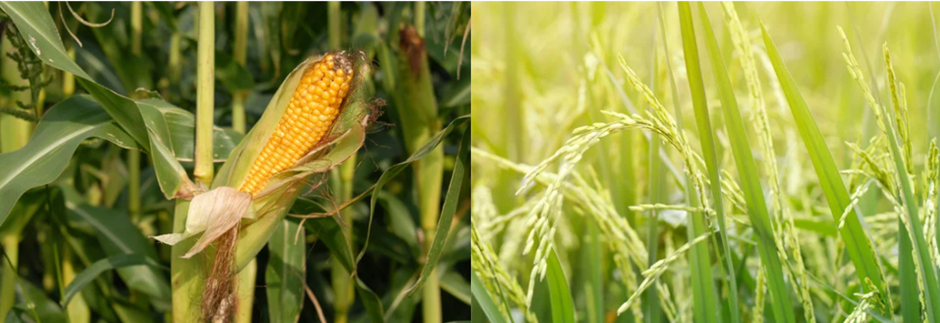
A. PALAY PRODUCTION
For the year 2024, Ifugao Province produced a total of 28,337.25 metric tons of palay. Compared to the year 2023, production decreased by 34,201.71 metric tons or -17.15 percent less. The decrease was attributed to the decrease in yield per hectare of the palay areas. (Table 1)
Table 1: Palay Production, Area Harvested and Yield Per Hectare, Ifugao, 2023-2024
ITEM | 2023 | 2024 |
GROWTH RATE |
PRODUCTION (MT) | 34,201.71 | 28,337.25 | -17.15% |
31,763.58 | 26,634.55 | -16.15% | |
Rainfed | 2,438.13 | 1,702.70 | -30.16% |
|
|
|
|
AREA HARVESTED (HA.) | 12,107.87 | 11,112.21 | -8.22%
|
Irrigated | 11,346.87 | 10,489.41 | -7.56% |
Rainfed | 761.00 | 622.80 | -18.16% |
|
|
|
|
YIELD (MT/Ha) | 2.82 | 2.55 | -9.72% |
Irrigated | 2.80 | 2.54 | -9.29% |
Rainfed | 3.20 | 2.73 | -14.67% |
Source: Philippine Statistics Authority, Palay Production Survey (PPS)
Production for Irrigated Palay constituted 89.96 percent of the total palay production of the province for the year 2024. 3.41% for Rainfed areas harvested for the year 2024 and 2023. (Figure 1)
Figure 1: Total Palay Production (MT), Ifugao Province Quarter 2024 and 2023
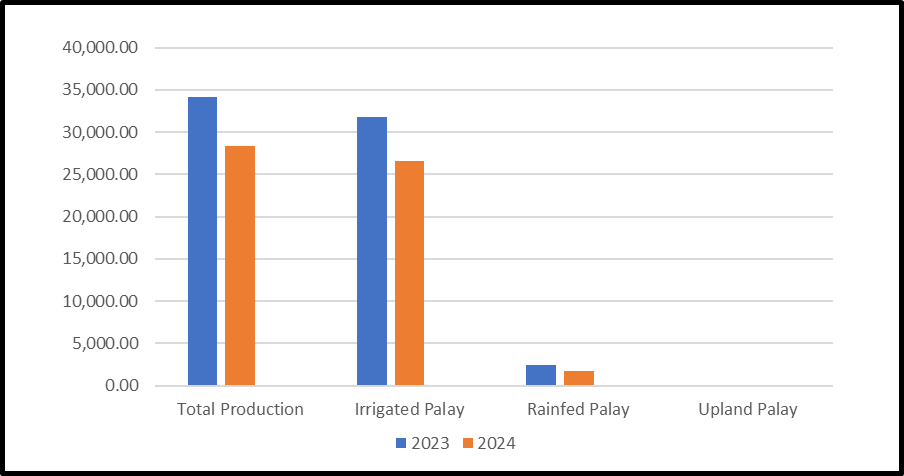
Source: Philippine Statistics Authority, Palay Production Survey (PPS)
The total palay area harvested for the year 2024 in the province was recorded at 11,112.21 hectares, which was lower in 2023 recorded 12,107.87 hectares. The area harvested for Irrigated palay recorded 10,489.41 hectares represented 94.40% of the total palay area harvested while Rainfed Palay recorded 622.80 hectares represented 5.60% of the total palay area harvested in the province. No Upland Palay harvested for the year 2023 and 2024. (Figure 2)
Figure 2: Total Area Harvested (ha), Ifugao Province Second Quarter 2024 and 2023
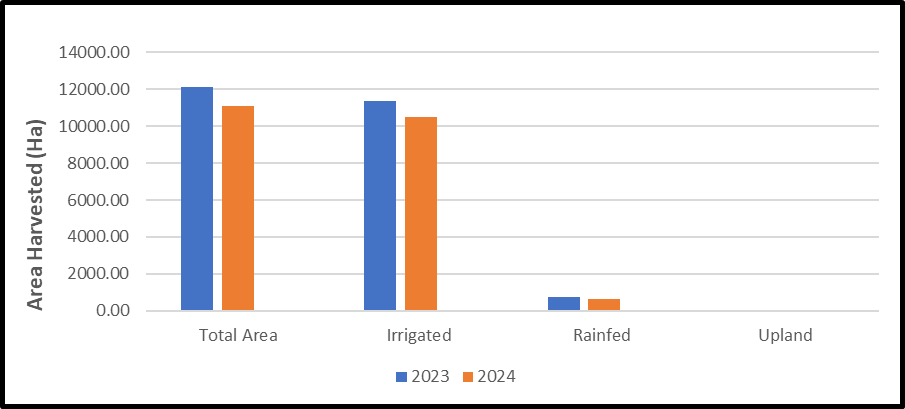
Source: Philippine Statistics Authority, Palay Production Survey (PPS)
The average yield (Mt/Ha) of palay in the province for the year 2024 was recorded at 2.55 metric tons per hectare which was lower by 9.72 percent or -0.27 metric tons per hectare compared to the 2.82 metric ton per hectare for the year 2023. (Figure 3)
Figure 3: Average Yield, Ifugao Province Second Quarter 2024 and 2023
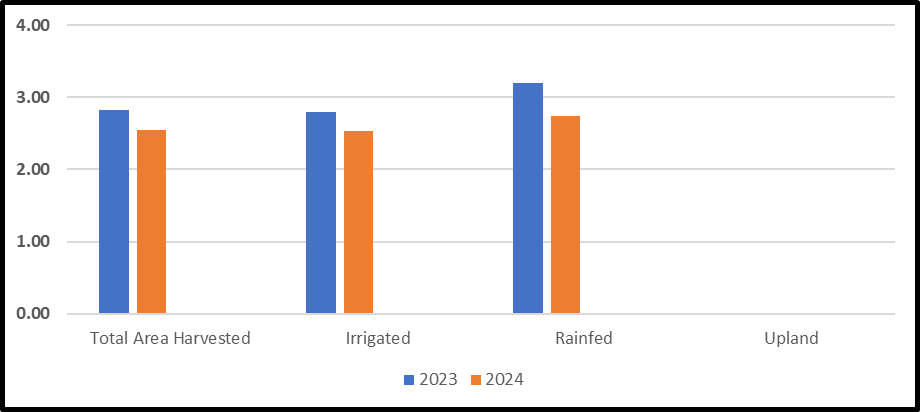
Source: Philippine Statistics Authority, Palay Production Survey (PPS)
B. CORN PRODUCTION
As for corn production, Ifugao Province produced a total of 54,469.96 metric tons of corn for the year 2024. Production increased by 2,685.95 metric tons or 5.19 percent more compared to the year 2023. The increase was attributed to the insufficient rainfall and presence of insect pests on the corn areas. (Table 1)
Table 2: Corn Production, Area Harvested and Yield Per Hectare, Ifugao 2023-2024
ITEM | 2023 | 2024 |
GROWTH RATE |
PRODUCTION (MT) | 51,784.01 | 54,469.96 | 5.19% |
White | 5.00 | 0.00 | -100.00% |
Yellow | 51,779.01 | 54,469.96 | 5.20% |
|
|
|
|
AREA HARVESTED (HA.) | 17,521.31 | 17,421.55 | -0.57% |
White | 5.00 | 0.00 | -100.00% |
Yellow | 17,516.31 | 17,421.55 | -0.54% |
|
|
|
|
YIELD (MT/Ha) | 2.96 | 3.13 | 5.79% |
White | 1.00 | 0 | -100.00% |
Yellow | 2.96 | 3.13 | 5.77% |
Source: Philippine Statistics Authority, Corn Production Survey (CPS)
Yellow corn production comprises the bulk of the total corn production of the province for the year 2024. However, it went up by 2,690.95 metric tons or -5.20 percent increase compared to the year 2023. (Figure 4)
Figure 4. Total Corn Production (MT), Ifugao, 2023-2024
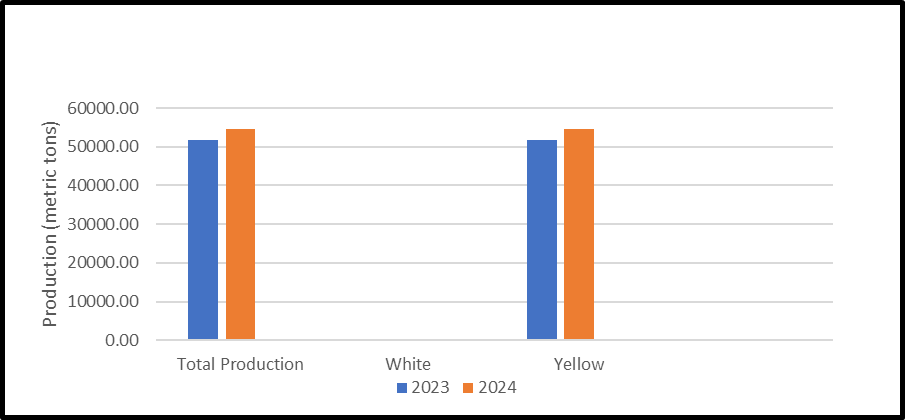
Source: Philippine Statistics Authority, Corn Production Survey (PPS)
The total corn area harvested for the year 2024 in the province was recorded at 17,421.55 hectares, which was lower in 2023 recorded 17,516.31 hectares. The area harvested for Yellow Corn recorded 100% of the total corn area harvested. (Figure 5)
Figure 5: Total Area Harvested (ha), Ifugao, 2023-2024

Source: Philippine Statistics Authority, Corn Production Survey (CPS)
The average yield (Mt/Ha) of corn in the province for year 2024 was recorded at 3.13 metric tons per hectare which was higher by 5.79 percent or 0.17 metric tons per hectare compared to the 2.96 metric ton per hectare of 2023.
Figure 6: Average Yield, Ifugao, 2023-2024
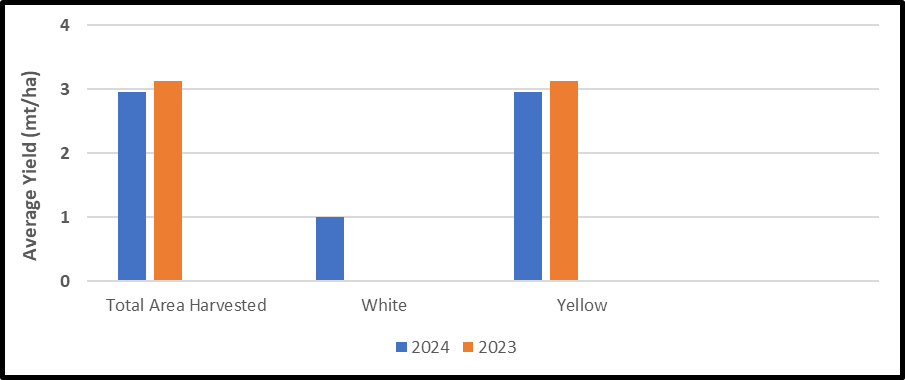
Source: Philippine Statistics Authority, Corn Production Survey (CPS)
Sgd
DELANO C. BOLISLIS JR.
Chief Statistical Specialist
PSA - Ifugao
TECHNICAL NOTES
The Palay Production Survey and Corn Production Survey are conducted quarterly by the Philippine Statistics Authority to generate estimates and forecasts on palay, area, and yield to provide data inputs for policy programs on rice and corn.
This survey was conducted in the province of Ifugao which covers sample farming households in its various municipalities with reference period, as follows:
April Round Survey – January to March
July Round Survey – April to June
October Survey Round – July to September
January Round Survey – October to December
For Inquiries, please contact:
GAVINO A. MONGALINI JR.
Statistical Analyst
DELANO C. BOLISLIS JR.
Chief Statistical Specialist
Philippine Statistics Authority
Provincial Statistics Office
Ground Floor New LMDC Building, J.P. Rizal Avenue,
Dullagan, Poblacion West,
Lagawe, Ifugao 3600



